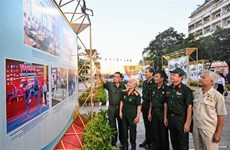Photo exhibition presents new perspectives on Hanoi
A photo exhibition at the Goethe Institute, Hanoi, presents a lovely insight into the capital of Vietnam and its people.
A photo exhibition at the Goethe Institute, Hanoi, presents a lovely insight into the capital of Vietnam and its people.
The photos show living spaces tucked away in alleys, architectural development over the centuries, people savouring a meal on the sidewalk, or rushing to work in a wild river of traffic and so on.
Using five different viewpoints and five different cameras, Vietnamese and foreign photographers have captured "the joy and the sadness at the end of the alley in the heart of Hanoi."
Their photographs are displayed in the Lost&Found Hanoi exhibition, which opens on April 17 following the launch of a book of the same name by Thing Asian Press on April 16.
Flipping through the glossy pages of the book, one is tempted to lose oneself in this city, discovering places which will make Hanoi feel like a private terrain which rewards those who learn how to let the city take them in.
There are images showing the exuberance of boys taking flight on skateboards, the trendy chic of hipsters in tattoos and elegantly tailored blue jeans and the beauty of ageing faces whose countenances have been shaped by decades of struggle.
"When we live in a familiar environment for too long, it is difficult for us to recognise our own problems with the surrounding environment. Therefore, I often pretend I am not from here so that I can travel and explore life and the living environment of my own city," said photographer Nguyen The Son.
"A vision with a different point of view has brought me a variety of unexpected results. Through numerous visual art projects, I have investigated Hanoi where I was born and raised," he noted.
Besides photographers Son and Maika Elan of Vietnam, foreign photographers Elizabeth Rush, Matthew Dakin and Aaron Joel Santos have also displayed their photos.
"Everything in Hanoi has texture, be it the scored construction sites, the slick plastic tables and chairs, the flower nurseries and tarpaulin strung up along Thuy Khue, and even the air, which sticks to my teeth as I ride through the streets at dawn," said Rush at the book-launch ceremony.
Rush is an American writer and photographer who has crossed borders with Bangladeshi cattle smugglers, built homes with Lima's squatters, climbed abandoned buildings on Hanoi's periphery and participated in the underground performance art scene in Yangon, Myanmar.
The exhibition is open to the public until May 18 at Goethe-Institute Hanoi, 56-58 Nguyen Thai Hoc street.-VNA
The photos show living spaces tucked away in alleys, architectural development over the centuries, people savouring a meal on the sidewalk, or rushing to work in a wild river of traffic and so on.
Using five different viewpoints and five different cameras, Vietnamese and foreign photographers have captured "the joy and the sadness at the end of the alley in the heart of Hanoi."
Their photographs are displayed in the Lost&Found Hanoi exhibition, which opens on April 17 following the launch of a book of the same name by Thing Asian Press on April 16.
Flipping through the glossy pages of the book, one is tempted to lose oneself in this city, discovering places which will make Hanoi feel like a private terrain which rewards those who learn how to let the city take them in.
There are images showing the exuberance of boys taking flight on skateboards, the trendy chic of hipsters in tattoos and elegantly tailored blue jeans and the beauty of ageing faces whose countenances have been shaped by decades of struggle.
"When we live in a familiar environment for too long, it is difficult for us to recognise our own problems with the surrounding environment. Therefore, I often pretend I am not from here so that I can travel and explore life and the living environment of my own city," said photographer Nguyen The Son.
"A vision with a different point of view has brought me a variety of unexpected results. Through numerous visual art projects, I have investigated Hanoi where I was born and raised," he noted.
Besides photographers Son and Maika Elan of Vietnam, foreign photographers Elizabeth Rush, Matthew Dakin and Aaron Joel Santos have also displayed their photos.
"Everything in Hanoi has texture, be it the scored construction sites, the slick plastic tables and chairs, the flower nurseries and tarpaulin strung up along Thuy Khue, and even the air, which sticks to my teeth as I ride through the streets at dawn," said Rush at the book-launch ceremony.
Rush is an American writer and photographer who has crossed borders with Bangladeshi cattle smugglers, built homes with Lima's squatters, climbed abandoned buildings on Hanoi's periphery and participated in the underground performance art scene in Yangon, Myanmar.
The exhibition is open to the public until May 18 at Goethe-Institute Hanoi, 56-58 Nguyen Thai Hoc street.-VNA













